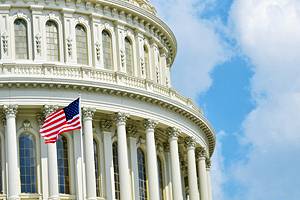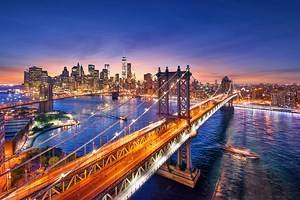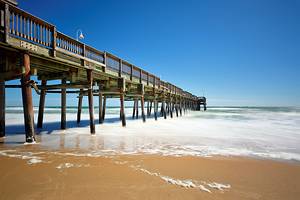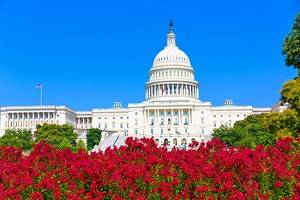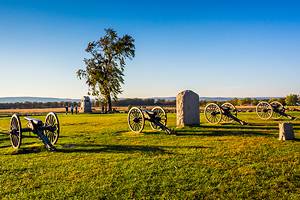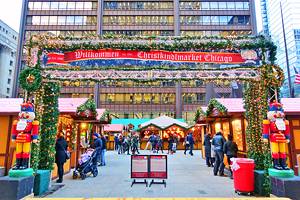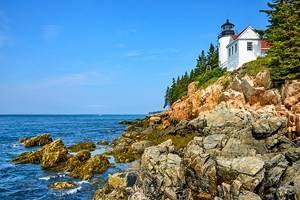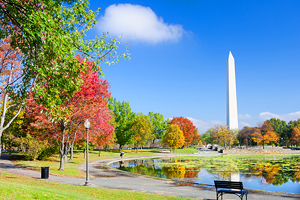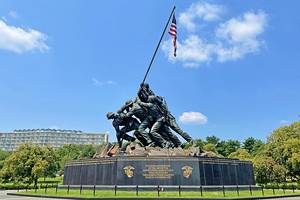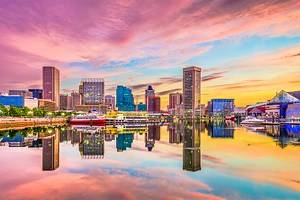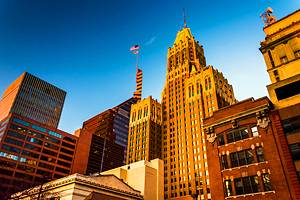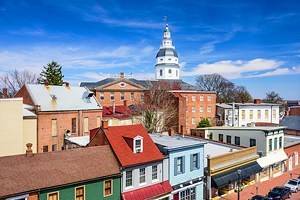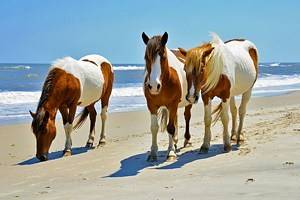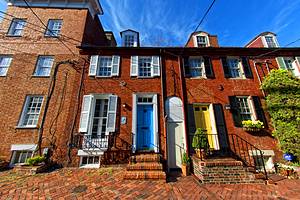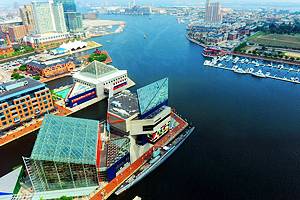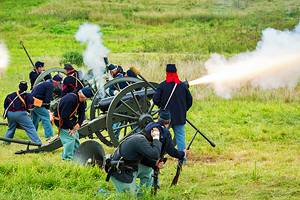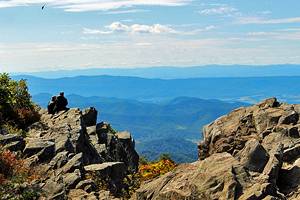Tourist Attractions in Washington, D.C.
Whether you are marveling at its white marble monuments and memorials, learning about history in one of its free Smithsonian museums, or getting a feel for how locals live in one of its vibrant neighborhoods, Washington, D.C. emits a pulsating energy not found anywhere else in the U.S. The District of Colombia is a city you can explore dozens of times and have a completely different experience with each visit.
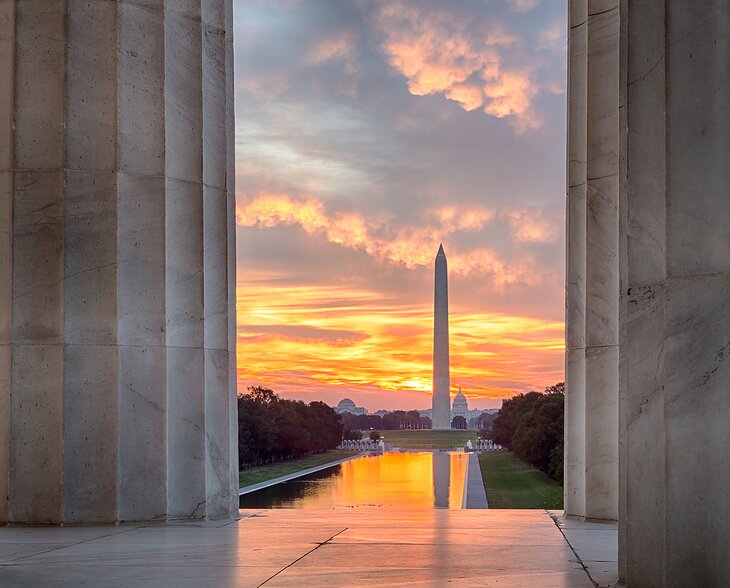
Designed by Pierre-Charles L'Enfant at the request of George Washington, America's capital city sits on the Potomac River between Maryland and Virginia. It is located on land specifically set aside after the Revolutionary War to keep the federal government from being in a single state.
L'Enfant planned for D.C. to feel larger than life with its wide avenues, inspirational marble buildings, public squares, and a magnificent "public walk," the National Mall. The city is split into four quadrants: NW, NE, SW, and SE and its layout is a street grid intersected by avenues.
First-time visitors flock to its list of must-see attractions like the White House, Capitol Building, and museums, monuments, and memorials, perfectly spaced along its park-style National Mall. But beyond these famed attractions, you will find another DC. One ruled by locals and influenced by the host of long-term international residents, and filled with eclectic neighborhoods including U Street, Adams Morgan, Dupont Circle, and Georgetown.
This is a city where you can eat your way across the world's food scene in the space of a few miles. It is also a city that boasts a world-class arts scene and outdoor experiences from paddleboarding on the Potomac River to walking or biking along the C&O Canal towpath.
If you can avoid visiting D.C. in the summer, do so. Besides being unpleasantly hot and humid, summers are when you'll see the biggest crowds. The best times to visit Washington are spring and autumn.
Plan your trip to the nation's capital with our list of the top attractions in Washington, D.C.
- United States Capitol and Capitol Hill
- The Lincoln Memorial
- The National Mall and Veterans Memorials
- The White House
- The Washington Monument
- National Air and Space Museum
- National Museum of Natural History
- National Gallery of Art
- Library of Congress
- National Museum of African American History and Culture
- United States Holocaust Memorial Museum
- National Museum of Asian Art (Freer Gallery of Art and the Arthur M. Sackler Gallery
- National Museum of American History
- Jefferson Memorial and Tidal Basin
- The John F. Kennedy Center for the Performing Arts
- National Zoological Park
- National Archives
- International Spy Museum
- Arlington National Cemetery
- Washington National Cathedral
- Georgetown Historic District
- Smithsonian American Art Museum and National Portrait Gallery
- U.S. Botanic Garden
- U Street Corridor
- The Wharf
- Best Time to Visit Washington, D.C.
United States Capitol and Capitol Hill
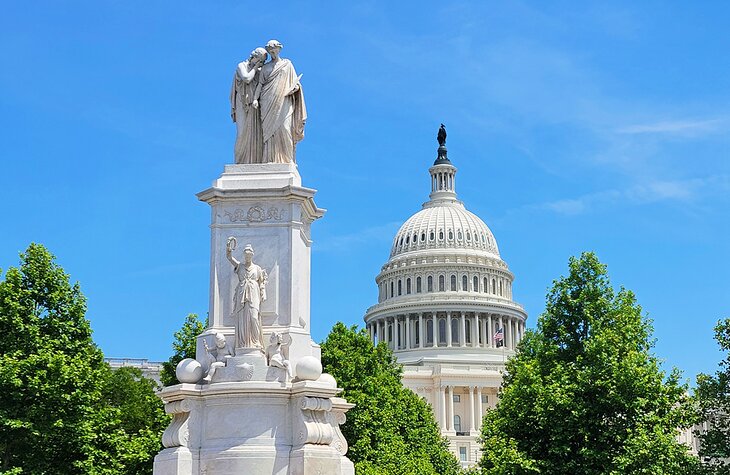
Recognized around the world as a symbol of the United States, the Capitol is the seat of the House of Representatives and the Senate. The huge dome, based on the dome of St. Peter's in Rome, stands out above all other Washington buildings.
Like Washington itself, the building has grown over the years since the central portion was built between 1793 and 1812. The last addition, in 1958-62, enlarged the main façade where presidents take the oath. On the other side, a marble terrace offers beautiful views over the mall and the city.
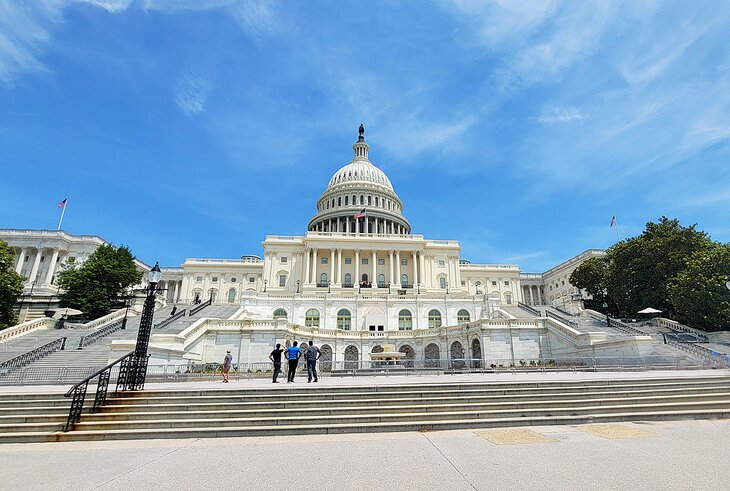
The interior is resplendent with frescoes, reliefs, and paintings, especially the rotunda under the great cast-iron dome with a ceiling painting by Constantino Brumidi and huge paintings of scenes from American history on the walls. Beside it is the former Chamber of the House of Representatives, with statues of leading historical figures. The small Senate Rotunda leads into the beautifully restored Old Senate Chamber, where the Senate met until 1859, and the Supreme Court until 1935.
Tours can be reserved online and begin at the visitor center on the lower floor, where there is an interesting exhibition on the building's history. Free tours on weekday afternoons explore the ornate paintings on the walls and ceilings of the corridors in the Senate wing, designed by Brumidi between 1857 and 1859. To visit the Senate or House in session, you need to contact your Senator or Representative for a pass; foreign visitors can arrange visits through the visitor center.
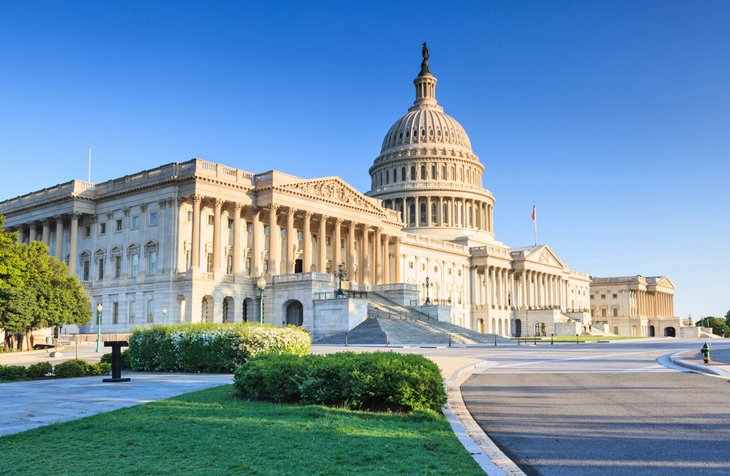
East of the Capitol are the Supreme Court Building; the Library of Congress; and Folger Shakespeare Library, home of the world's largest collection of the printed works of William Shakespeare.
The Capitol Hill neighborhood extends southeast, with the lively Eastern Market, a farmers market with craft vendors, as well.
The Capitol is located at the east end of the National Mall. While on this side, you can combine it with a visit to the nearby United States Botanic Garden.
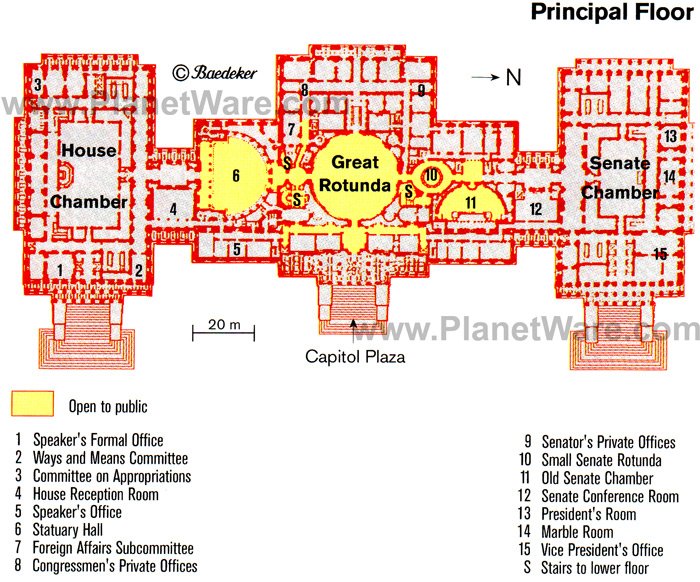
The Lincoln Memorial

The best-loved of all Washington's memorials, the Lincoln Memorial stands at the far west end of the mall, separated from the Washington Monument by the Reflecting Pool. At its center is a 19-foot marble statue of a seated and pensive President Abraham Lincoln surrounded by 36 columns, one for each of the states that existed at the time of Lincoln's death.
This is the most famous work designed by noted sculptor Daniel Chester French. Jules Guerin painted the murals on the inside walls, showing important events in Lincoln's life.
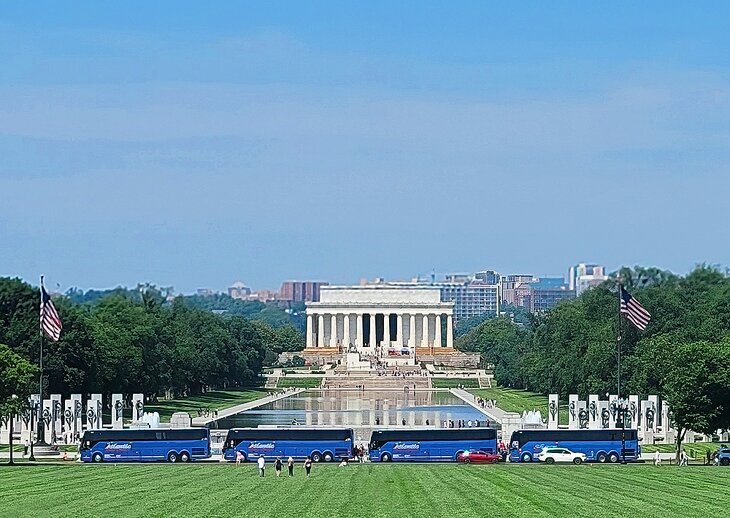
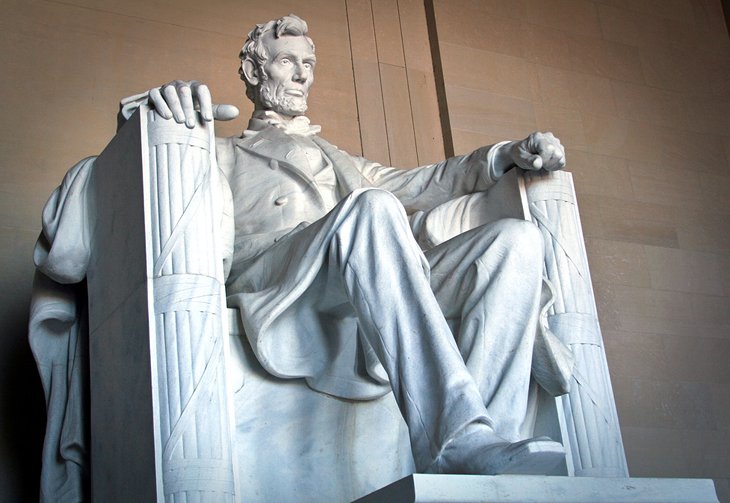
Since its completion in 1922, the Lincoln Memorial has been the scene of several historic events. In 1939, when the all-white Daughters of the American Revolution (DAR) refused to let celebrated African American singer Marian Anderson perform at a concert in nearby Constitution Hall, President Franklin Roosevelt and First Lady Eleanor Roosevelt arranged for her to give an open-air concert on the steps of the Lincoln Memorial, attended by 75,000 people and broadcast to millions of radio listeners.
Martin Luther King Jr. delivered his famous "I have a dream..." speech from the memorial steps in 1963, again making history here.
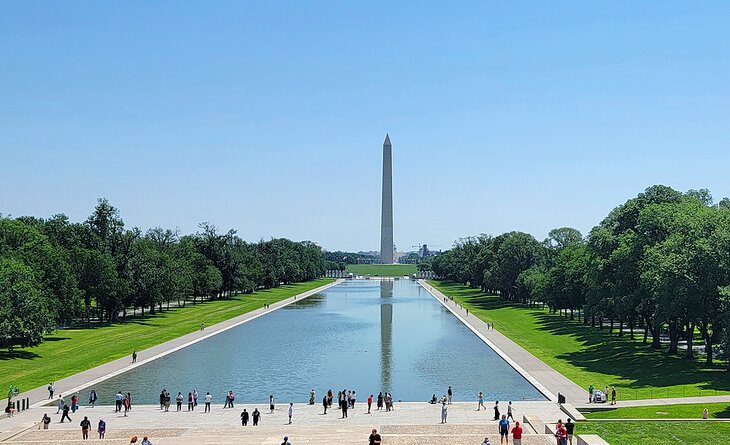
Visiting this and other Mall monuments is one of the favorite things to do in Washington, D.C. at night. The monuments are all lighted, and many, like the Lincoln Memorial, are open 24 hours. The statue of Lincoln is especially powerful lighted at night inside the darkened interior of the temple and framed by the floodlit white columns.
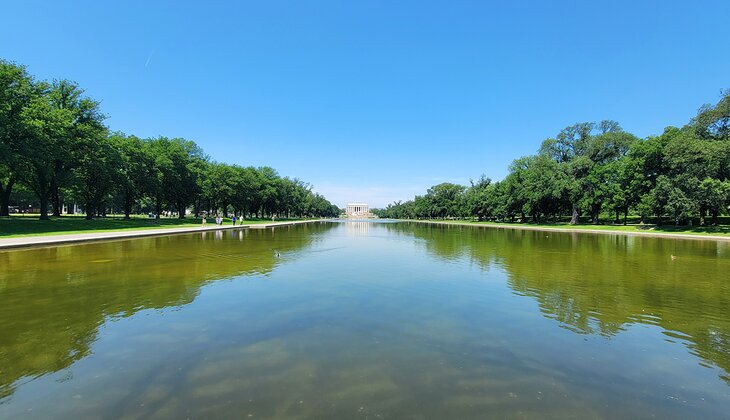
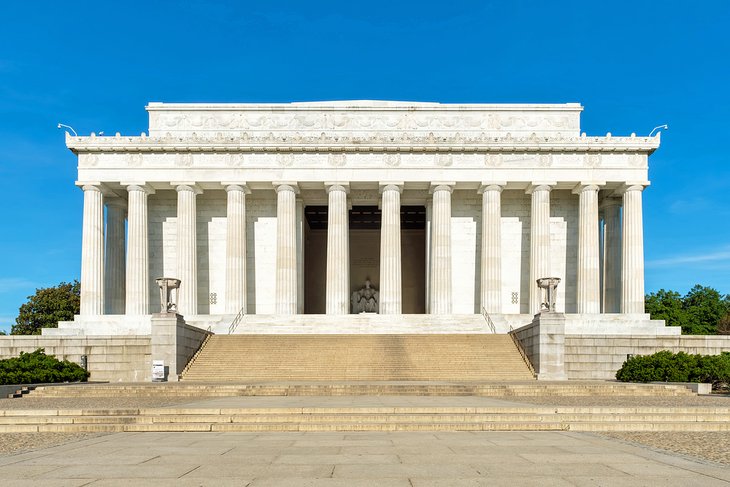
Address: 2 Lincoln Memorial Circle, NW, Washington, D.C.
The National Mall and Veterans Memorials
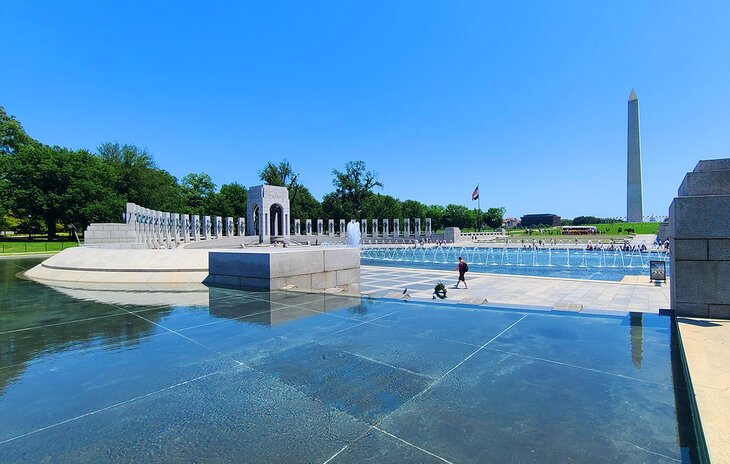
The National Mall is a spacious swath of lawns and pools that form a wide greenbelt from the Capitol Building to the Lincoln Memorial, and it is the site of many of Washington's landmark buildings, monuments, memorials, and museums. Most prominent at its center point is the Washington Monument. This is the best place to get an overview of the entire area. It's a high point and allows you to see from one end of the Mall to the other.
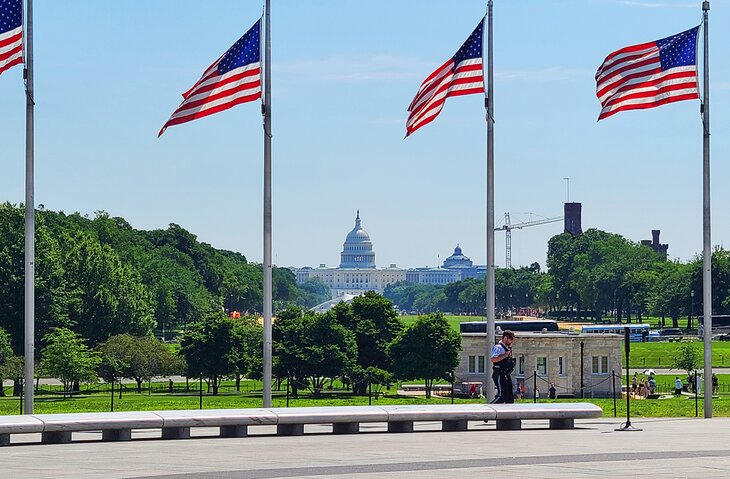
War Memorials
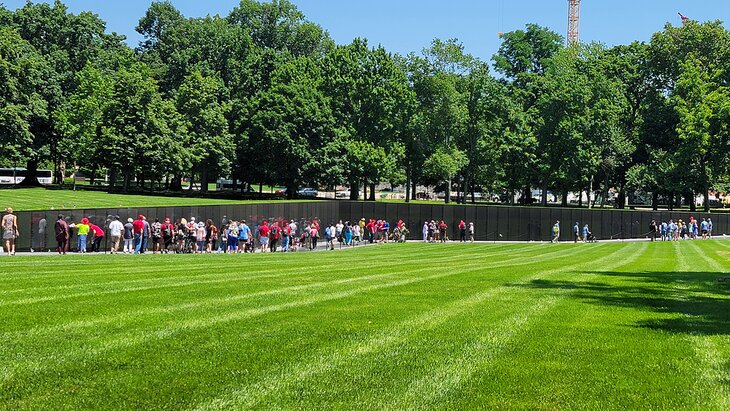
On the north side of the Lincoln Memorial is the Vietnam Veterans Memorial. This poignant wall inscribed with the names of all American servicemen and women who lost their lives or are missing, is one of Washington's most visited memorials. Nearby are the Vietnam Women's Memorial, a bronze sculpture of three servicewomen helping a wounded soldier, and the Three Servicemen statue.
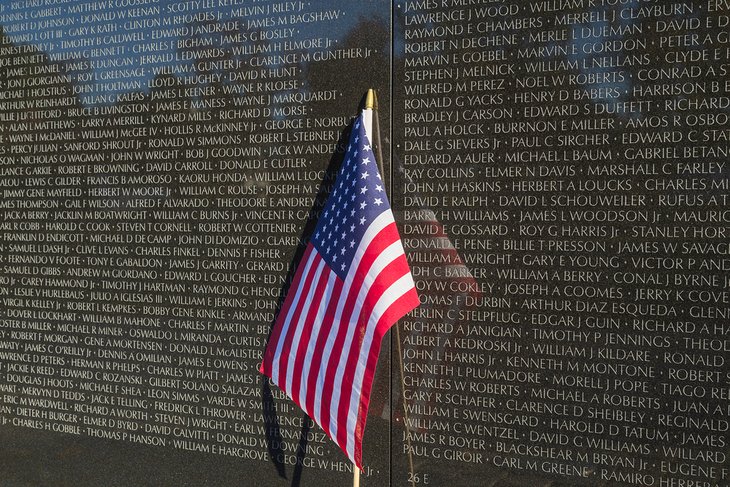
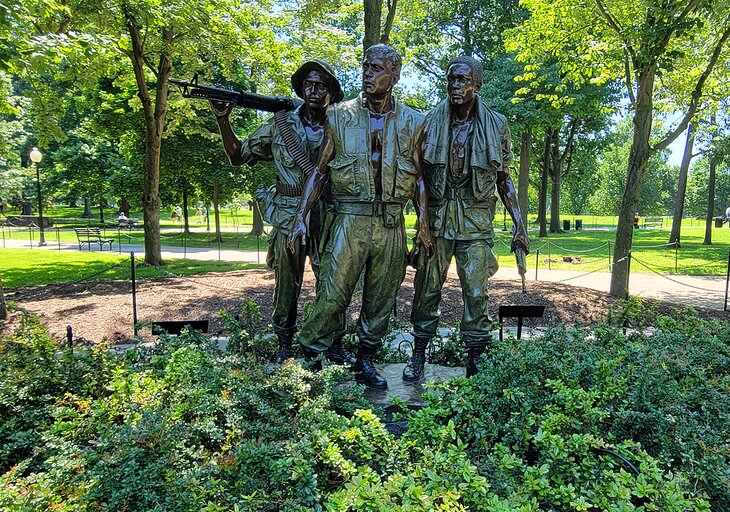
On the south side of the Lincoln Memorial is the Korean War Veterans Memorial, which contains 19 steel sculptures of soldiers.
At the east end of the Lincoln Memorial Reflecting Pool is the World War II Memorial, a beautiful oval plaza with sculptures and water features.
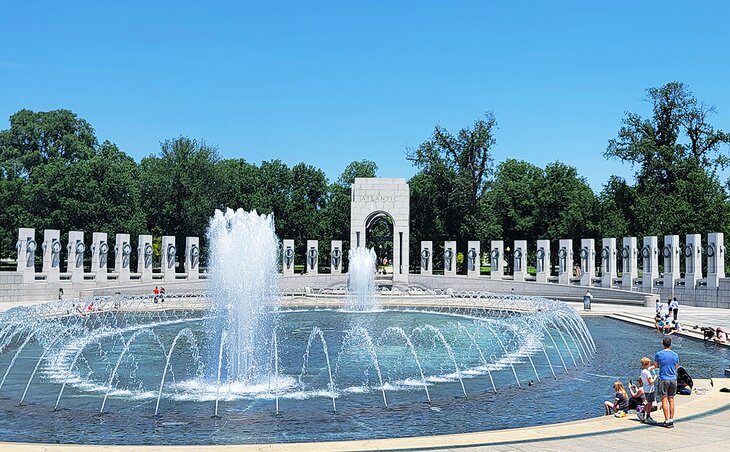
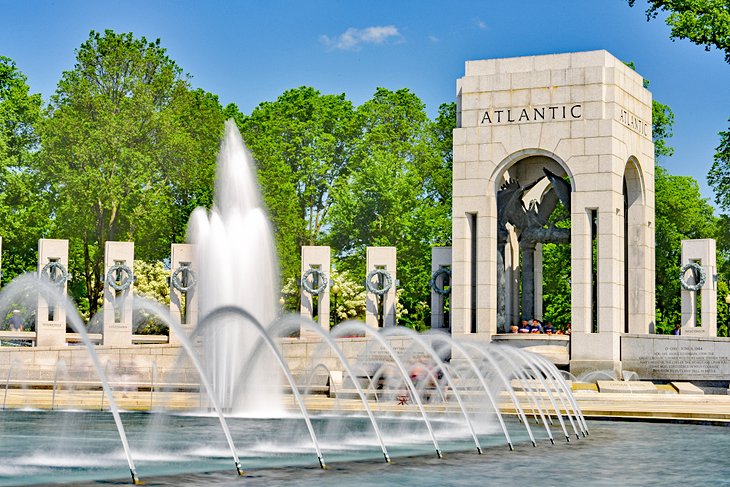
The newest is the American Veterans Disabled for Life Memorial, dedicated in 2014, but this is located near the United States Botanic Garden, closer to the Capitol.
Not on the Mall, but also significant is the WWI Memorial, located in the 1400 block of Pennsylvania Ave NW.
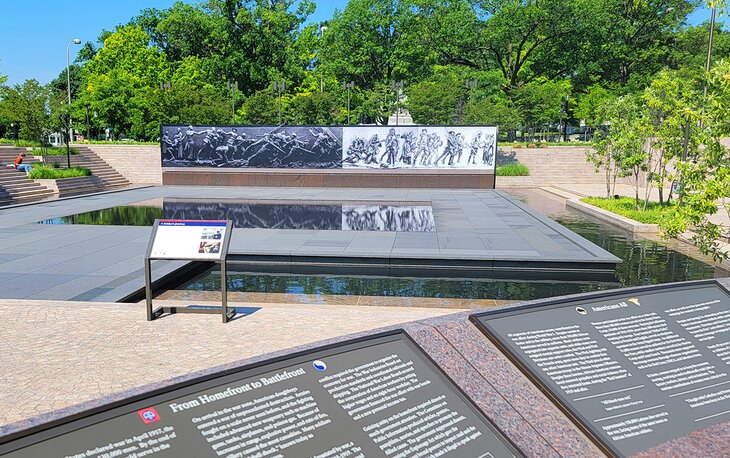
Museums on the National Mall
At the center of the National Mall is the huge Washington Monument. Continuing east from the Washinton Monument, you'll find many of Washington's most important museums. This includes the National Museum of African American History and Culture, The Smithsonian National Museum of Natural History, The National Gallery of Art, the Smithsonian National Air and Space Museum, the National Museum of Asian Art, the Hirshhorn Museum and Sculpture Garden, and others. These museums are all free of charge but a couple require a reservation, which gives you a timed admission.
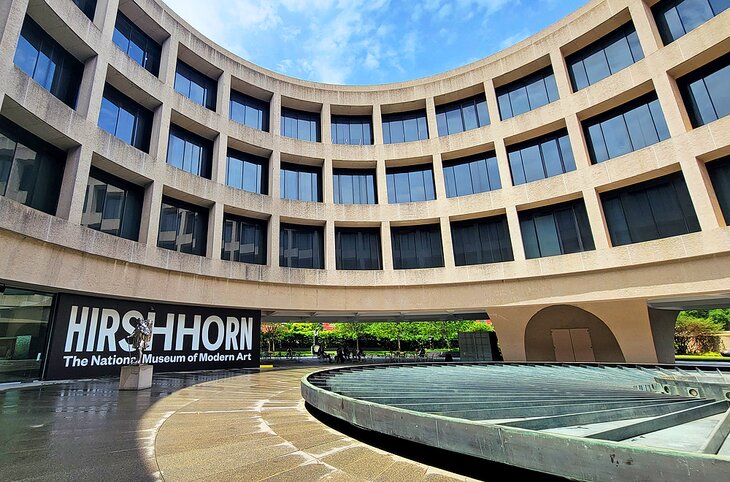
Events and Festivals
Along with providing a park for walking, running, and picnicking, the Mall is a place for celebrations and festivals. Best known of these is the annual Independence Day celebration with fireworks around the Washington Monument.
Also in July, the Smithsonian American Folk Life Festival fills the Mall with music, crafts, performances, storytelling, cultural programs, and food from various regions around the country. The Smithsonian Kite Festival is held here in late March or early April.
On summer evenings, you can often find military bands performing at venues along the Mall. The US Navy Band has concerts at the Capitol steps overlooking the Mall on Mondays and on Tuesdays at Navy Memorial. The US Air Force Band performs on the capitol steps on Tuesdays and at the Air Force Memorial on Fridays.
Location: Between Constitution Avenue and Independence Avenue, Washington, D.C.
The White House
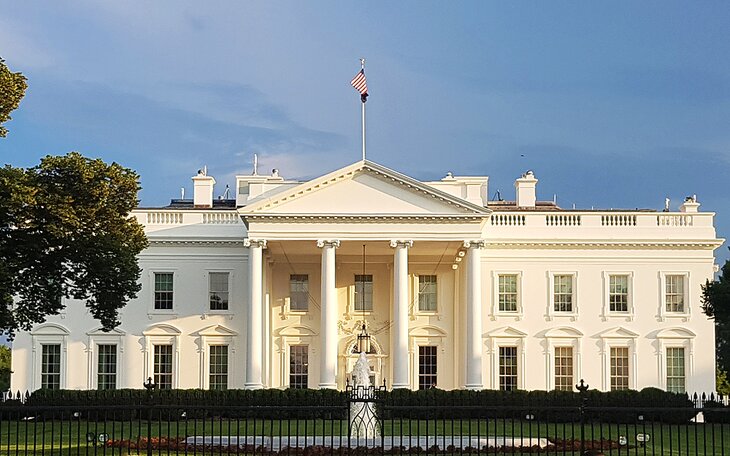
The White House is the official residence of the President of the United States. The home of every president except George Washington, it was originally built by James Hoban in 1792, and after being burned down by British forces in 1814 was rebuilt in 1818.
Although tours of the interior that include the East, Blue, Green, and Red Rooms; the Ballroom; and the State Dining Room must be reserved well in advance through your Congressional office or embassy, every tourist to Washington will want to see this iconic building, at least from the outside.
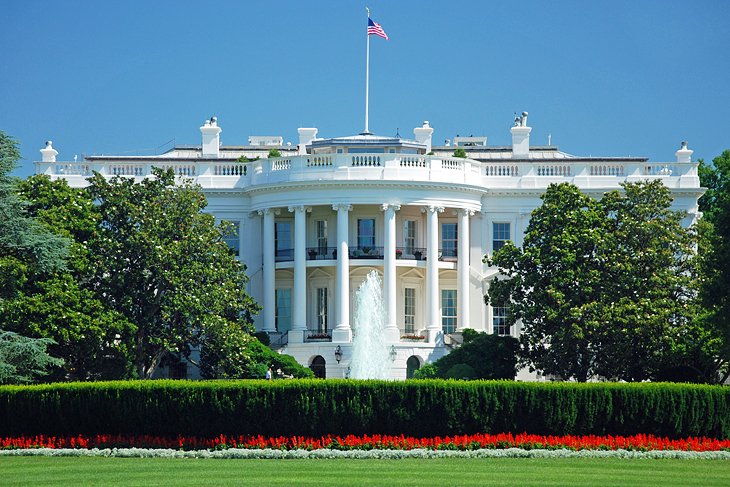
The free White House Visitor Center, a short distance away, off 15th St. NW on Pennsylvania Avenue, has excellent interactive exhibits related to the White House and the presidential families. It includes furniture of past presidents, a model of the residence, historical changes, and videos with insights from presidents about their time living there.
The Ellipse, a 54-acre stretch of lawn stretching to Constitution Avenue, hosts summer concerts by the US Army Band. Next door to the White House is the elaborate 1833 Greek Revival Treasury Building and the 1871 Executive Office Building, one of the most striking old government buildings in Washington.
From Lafayette Square, one of the city's best-known, statues of Lafayette and others look over the White House.
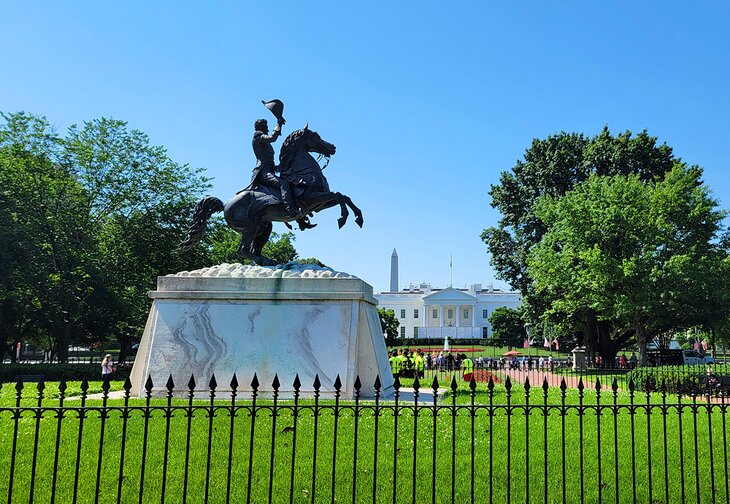
If you're looking to grab lunch or dinner near the White House, the Old Ebbitt Grill is a wonderful and historic option. Established in 1856, this is a bit of a Washington institution and the city's oldest saloon. It's been frequented by politicians and famous entertainers, contributing to its colorful history. Although it's an upscale restaurant, tourists will feel comfortable here in street clothes, and the menu features plenty of casual fare.
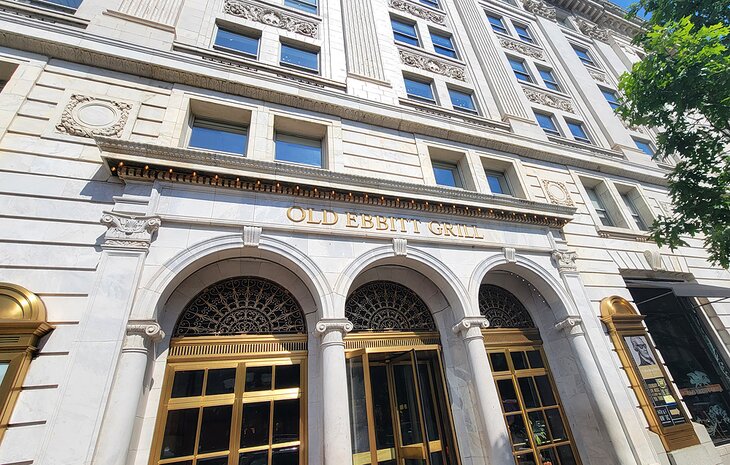
Address: 1600 Pennsylvania Avenue NW, Washington, D.C.
Official site: http://www.nps.gov/whho/index.htm
The Washington Monument
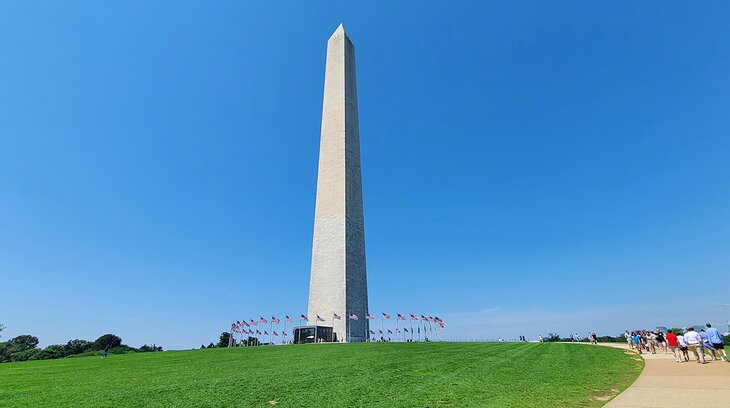
The 555-foot white shaft of the Washington Monument is a familiar icon of the National Mall, and a beautiful sight, especially when mirrored in the long Reflecting Pool at its foot. Construction of the obelisk to honor the nation's first president did not proceed smoothly. The plan was approved by Congress in 1783, but ground wasn't broken until 1848.
When the tower reached 156 feet in height in 1854, political wrangling and lack of funds stopped the project for several years, and the Civil War caused further interruption so that the tower was not capped until 1885, when it was finally completed by the Army Corps of Engineers.
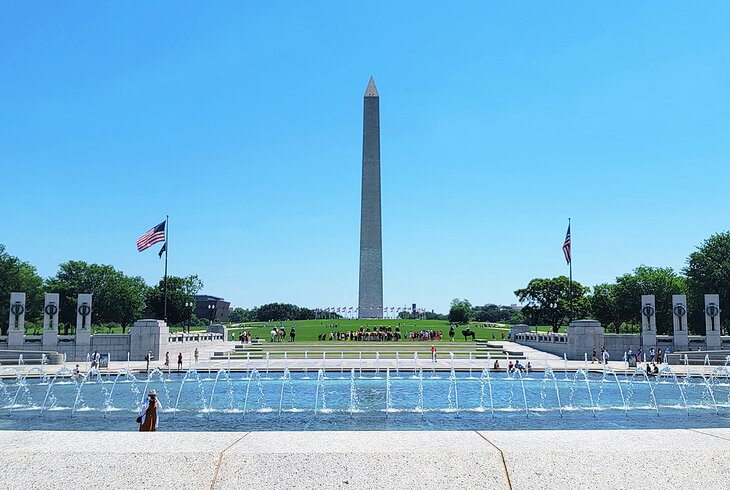
You can still see the separate stages of its building through three changes in the color of its facing stones; inside are engraved stones from states, cities, foreign countries, individuals, and civic groups, many of them donors who helped in its private funding stages. You can take an elevator to the very top for aerial views over the mall and much of Washington. The base of the monument is surrounded by a circle of 50 American Flags.
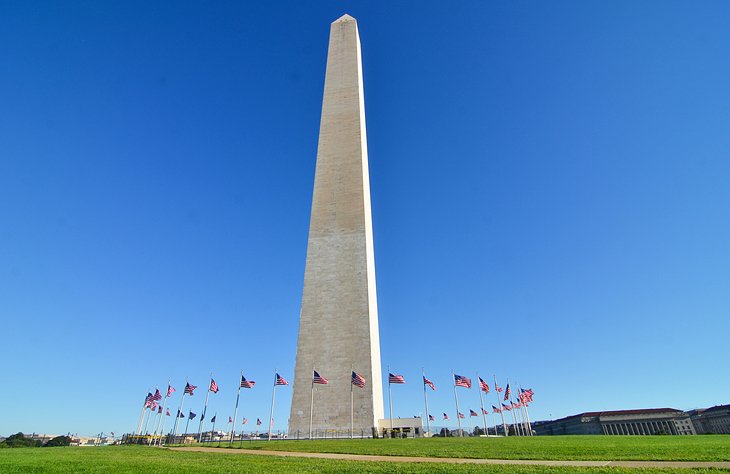
Address: 15th & Constitution Avenue NW, Washington, D.C.
National Air and Space Museum
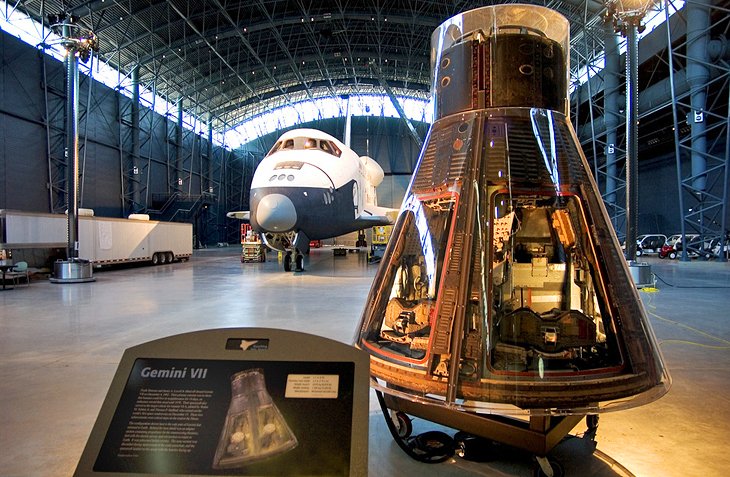
The National Air and Space Museum is one of the world's most popular museums, with a collection of history-making air and spacecraft that includes the original 1903 Wright Brothers Flyer and Charles Lindbergh's Spirit of St. Louis, the first plane to fly solo across the Atlantic Ocean.
More recent flight history is represented here by the Apollo 11 command module, part of the first manned lunar landing mission. Permanent and changing exhibitions illustrate the science, history, and technology of aviation and space flight, covering topics like the use of air power in both world wars, the space race, flight pioneers, and up-to-the-minute flight and space technology.
Many of the exhibits are interactive, and all contain actual historical objects, such as a moon rock you can touch. Not only do permanent exhibits illustrate the history, they also show the how and why of flight and space science, explaining how things fly, how jet engines work, and what keeps the International Space Station in orbit.
In addition to the exhibits, there is the Albert Einstein Planetarium, an IMAX theater, and the Public Observatory on the east terrace, where you can examine lunar craters and see planets and other astronomical features through telescopes. Flight simulators (fee charged) allow kids and adults to fly combat missions with aerial maneuvers like 360-degree barrel rolls or experience naval aviation in an F-18 Super Hornet.
The museum is also the home of the Udvar-Hazy Center in Chantilly, Virginia, adjacent to Dulles Airport, and has even more historic aircraft and space exploration artifacts, including a Concorde and the space shuttle Discovery. You can watch from observation walkways through the hangars where experts are restoring historic aircraft.
The Air and Space Museum is undergoing an extensive makeover that will transform not only the arrangement of 23 galleries but also the way it interprets the history and science of flight. Some areas of the museum are currently closed.
Address: 600 Independence Avenue SW, Washington, D.C.
Official site: www.nasm.si.edu
National Museum of Natural History
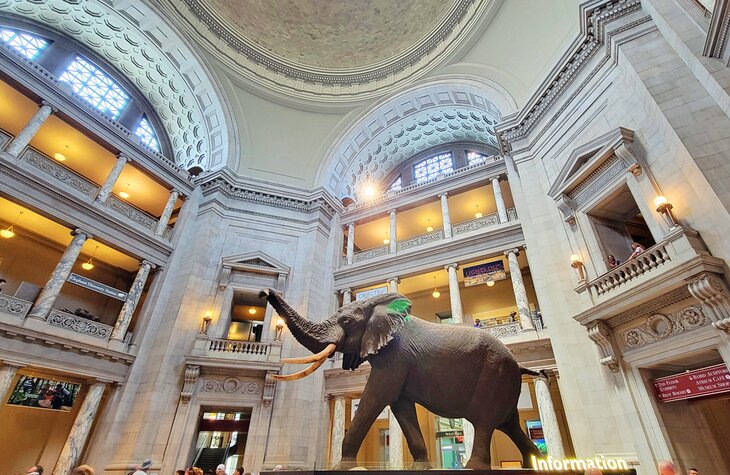
One of the most popular things to do with children in Washington, the Museum of Natural History explores the natural world with permanent and changing exhibits to interest all ages. From the minute you walk in, you're greeted with enormous, eye-catching displays, beginning with the huge African elephant in the rotunda.
Favorite exhibits include the renowned Hope Diamond and the dazzling collection of gems and minerals around it, and Ocean Hall with its stunning underwater photography and replica of a 45-foot North Atlantic Right Whale.
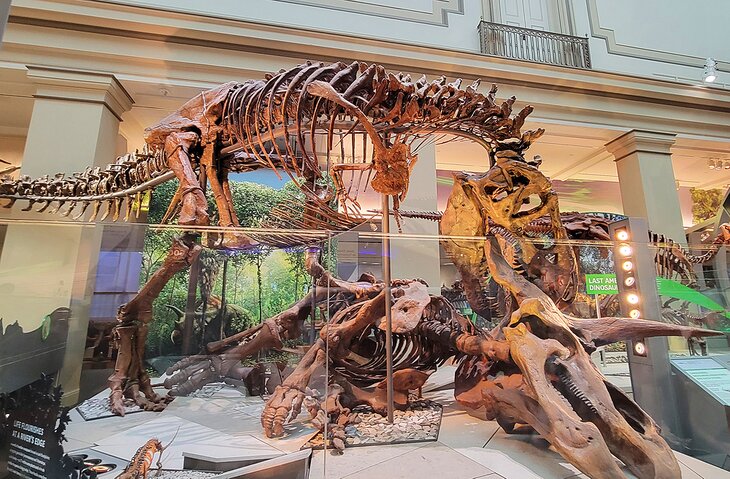
Also popular is the National Fossil Hall with numerous skeletons, including a T. rex and other giants towering over you.
The Hall of Human Origins follows human evolution over six million years in response to a changing world. Children will especially like the interactive Discovery Room where they can touch and play with various artifacts.

Like most museums in Washington, the Museum of Natural History is free and does not require reservations. You can pop in at any time. This is a busy, fun, and loud museum, where families will feel right at home.
If you're hungry, you can grab a bite from one of the food trucks right outside.
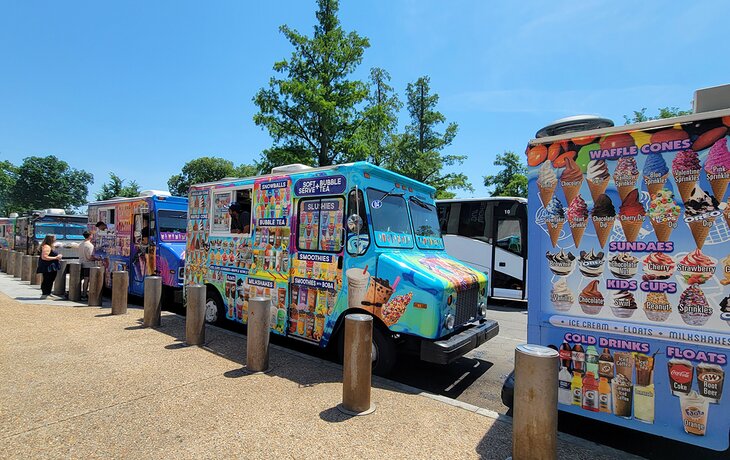
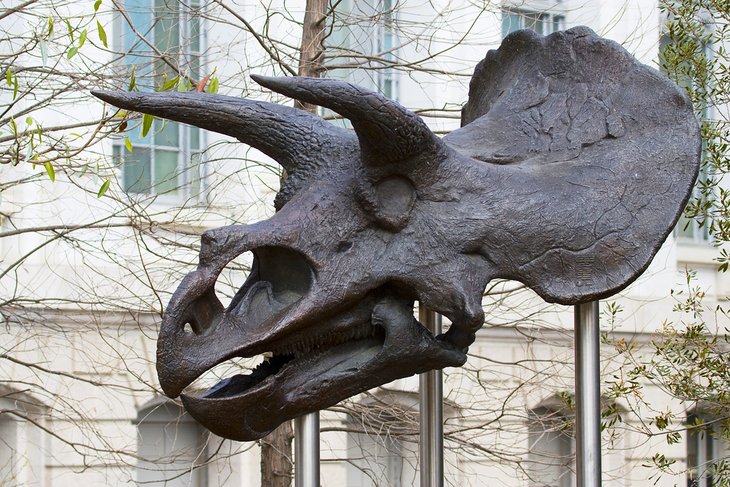
Address: Constitution Avenue NW, Washington, D.C.
Official site: http://www.si.edu/Museums/natural-history-museum
National Gallery of Art
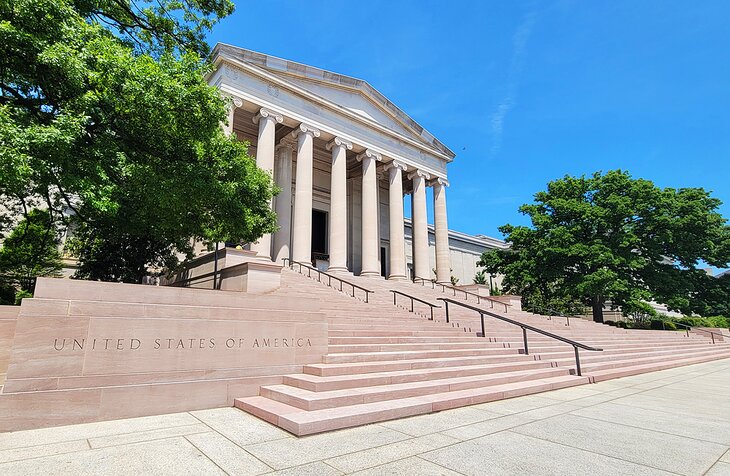
Housed in two separate buildings connected by a tunnel, the National Gallery of Art is one of the world's premier art museums and one of the most popular in the U.S. Based on the sizable collection of financier and later Treasury Secretary Andrew Mellon, its large and diverse collection includes masterpieces of European and American paintings, sculpture, and decorative arts.
Frequent temporary exhibitions add to this outstanding permanent collection to highlight arts from cultures around the world. Among the highlights is Ginevra de Benci, the only Da Vinci painting in any American museum. Others include works by major French Impressionists - Monet, Degas, and Renoir -- and other masterpieces by Rembrandt, El Greco, and Vermeer.
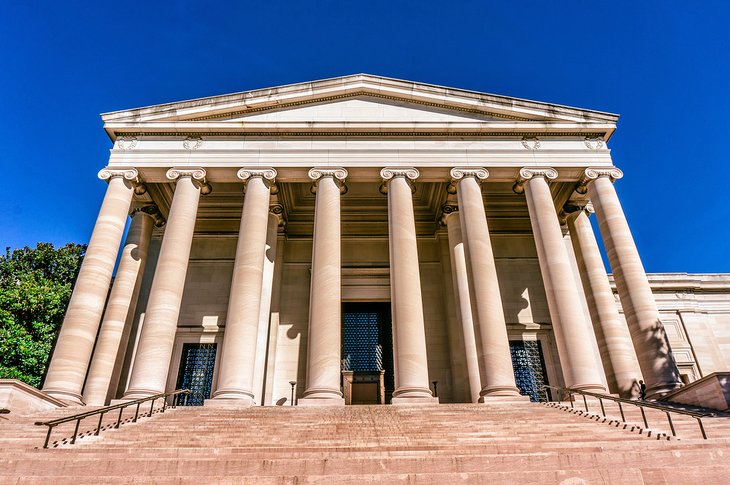
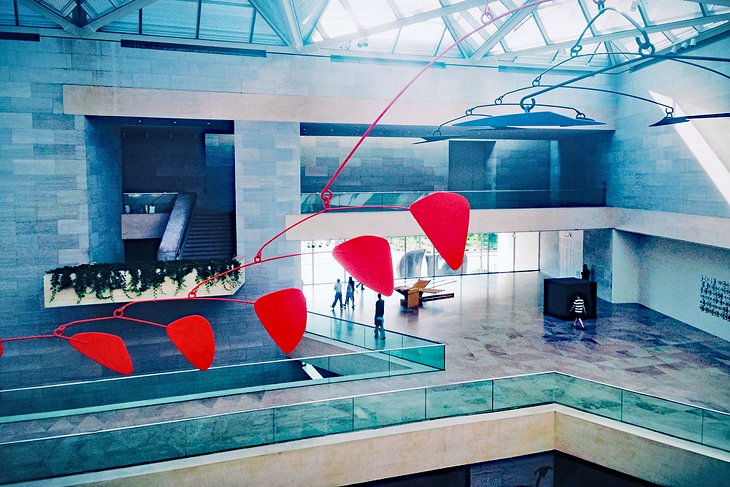
The newer East Wing features sculptures by Henry Moore, a mobile by Alexander Calder, and other modern works.
Between the East and West buildings is the Sculpture Garden, along with the lovely Pavilion Cafe. You can enjoy a meal while looking out over the garden, or wander through the artwork.
Free concerts are held at the National Gallery on Sunday evenings from fall through spring.
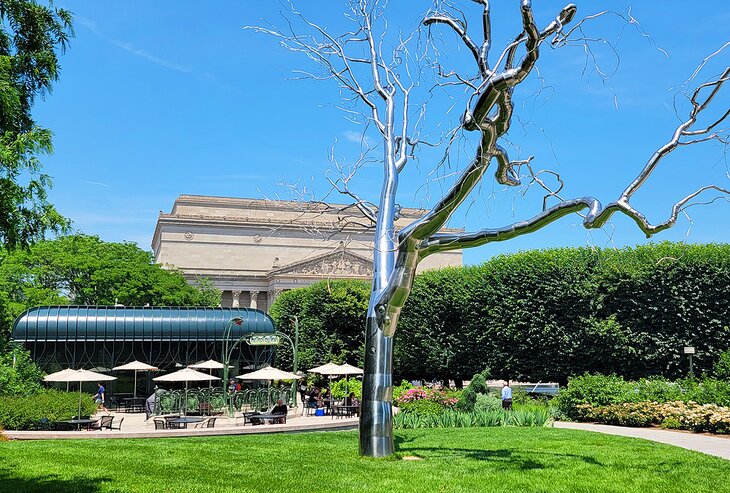
Address: 600 Constitution Avenue NW, Washington, D.C.
Official site: www.nga.gov
Library of Congress
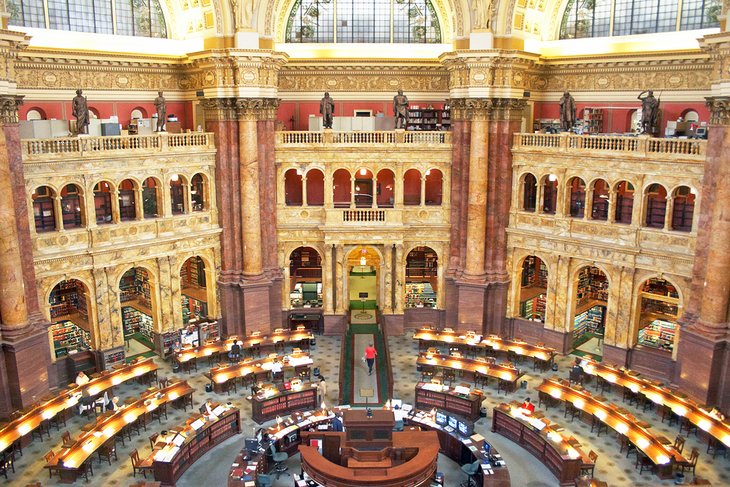
An underground passage with historical exhibits leads from the Capitol Building to one of Washington's little-known places to visit, the Library of Congress. It's the world's largest library, modeled on the Opera House in Paris. You can visit portions on your own, but free tours disclose even more of its beautiful interior.
Displayed here are one of the three surviving complete Gutenberg Bibles, an earlier hand-printed Bible, Thomas Jefferson's draft of the Declaration of Independence, Jefferson's personal library, and galleries filled with exhibits focusing on topics as varied as the musical careers of the Gershwin brothers and the work of editorial cartoonists and graphic artists.
Address: Capitol Hill, Washington, D.C.
Official site: https://www.aoc.gov/
National Museum of African American History and Culture
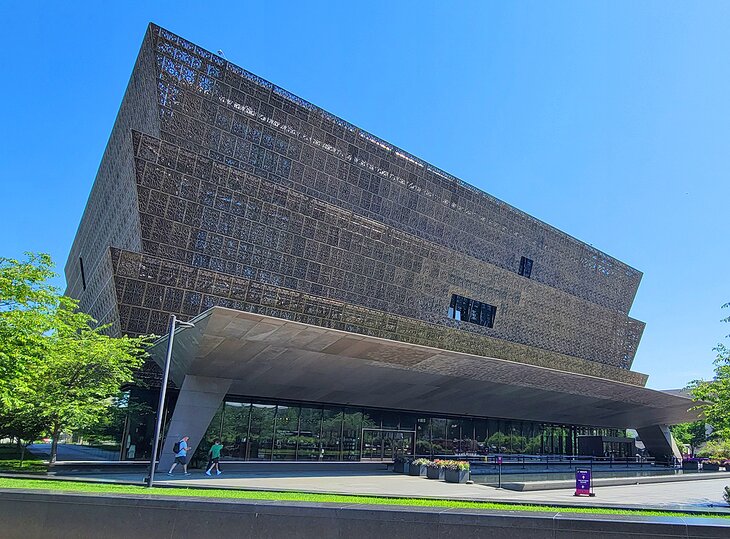
Focusing on themes of history, culture, and community, the newest of the Smithsonian museums explores changing definitions of American citizenship and equality, at the same time highlighting African American culture and that of the entire African diaspora.
Various themes are covered in changing exhibits, which center on themes such as African American food traditions and chefs, the influence of African American sports stars on the breakdown of segregation, and African craftsmanship.

Historic artifacts on display include a section of the original Woolworth lunch counter that was the scene of the Greensboro, N.C. sit-in in 1960, and the aircraft known as the "Spirit of Tuskegee." In World War II, it was used to train African American airmen in the Army Air Forces, men whose work helped trigger the desegregation of the military.
Address: National Mall at Constitution Avenue, N.W., between 12th and 14th Streets
Official site: https://nmaahc.si.edu/
United States Holocaust Memorial Museum

Near the Smithsonian museums, the United States Holocaust Memorial Museum documents, studies, and interprets the history of the Holocaust with the dual purpose of memorializing the victims and helping the world to confront hatred and prevent genocide.
Permanent exhibits examine the rise of the Nazis and the Aryan ideology, the ghettos, key events such as Kristallnacht, the concentration camps, and the Nazi atrocities. An exhibit on Americans and the Holocaust examines US reaction to Nazis, the war, and genocide, while another features personal accounts by US soldiers and citizens who witnessed the evidence of Nazi atrocities.
The presentations draw on the enormous collections of more than 12,750 artifacts, 85,000 historical photographs, 9,000 oral history testimonies, as well as archival footage and records of survivors and their families. A visit to the museum is a sobering experience.
Address: 100 Raoul Wallenberg Pl SW, Washington, D.C.
Official site: https://www.ushmm.org
National Museum of Asian Art (Freer Gallery of Art and the Arthur M. Sackler Gallery
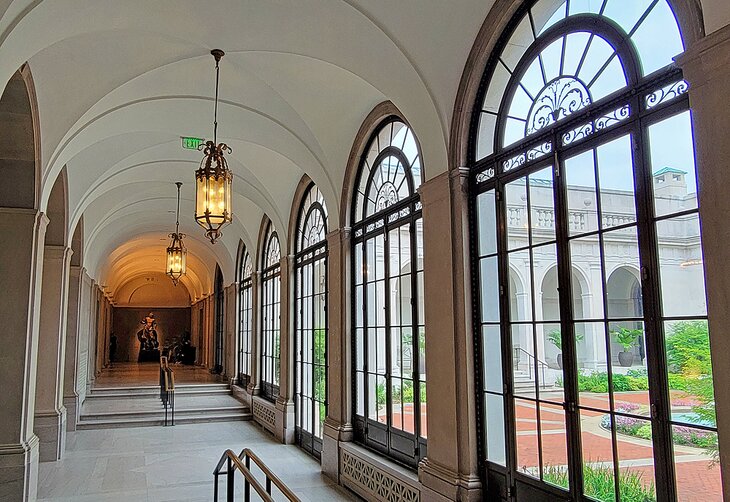
Also part of the Smithsonian Institution and located on the mall are the two museums that comprise the National Museum of Asian Art. These are the Freer Gallery of Art and the Arthur M. Sackler Gallery.
The Freer collection includes nearly 30,000 pieces of Asian artworks, including Buddhist sculptures and Persian manuscripts, one of the most extensive collections in the world. The Cosmic Buddha Vairochana is one of the most important pieces of the collection. The Freer also features 19th-century and early 20th-century American art, most notably a large collection of work by James McNeill Whistler.
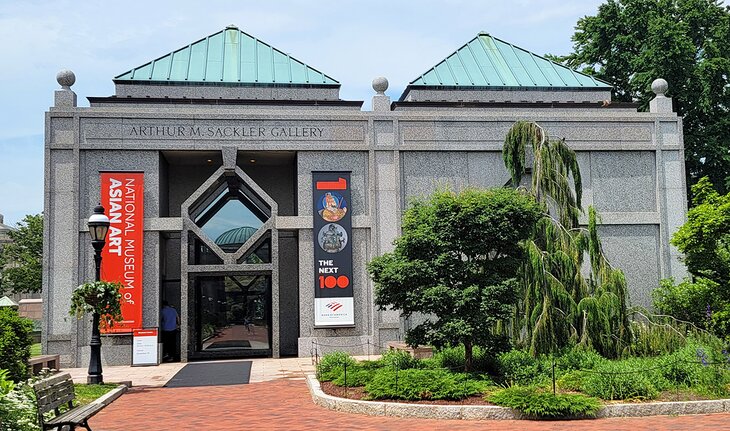
The Arthur M. Sackler Gallery, located adjacent to the National Museum of African Art, houses more than 1,000 pieces, including an extraordinary collection of Chinese jade and bronze, Chinese paintings and lacquerware, and ancient Near Eastern ceramics and metalware.
The design of the building means you enter the Sackler Gallery at ground level and descend to the lower floors to see the collections.
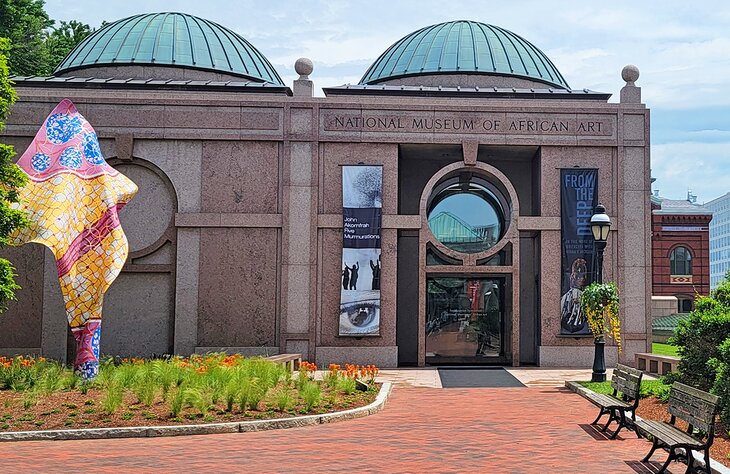
Right next door and definitely worth visiting, the National Museum of African Art displays thousands of objects representing diverse artistic styles throughout the African continent, including sculptures, masks, costumes, household objects, and ceramics. This museum is almost a mirror of the Sackler, with collections held in below-ground galleries.
These museums are free and do not require a timed admission reservation.
Official Site: https://asia.si.edu/
National Museum of American History
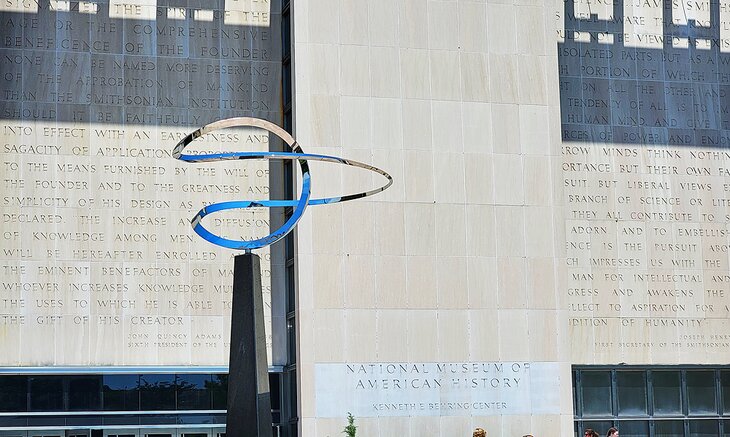
The National Museum of American History covers an extensive range of topics and is likely far more entertaining than you might expect. From treasured national historical artifacts like Thomas Jefferson's desk to rock icon Prince's guitar, you'll find a real mix of exhibits.
One of the most popular of the Smithsonian's many museums that line the mall, The National Museum of American History traces the political, cultural, scientific, and technological history of the U.S. since the Revolution. It displays important pieces of Americana, including, one of Edison's light bulbs, and the original flag that inspired Francis Scott Key to write the words to The Star Spangled Banner.
But beyond these treasured national artifacts, exhibits also examine how people lived, what they ate, where they worked, how they played, what they wore, how they traveled, how they worshiped, and how they governed themselves.
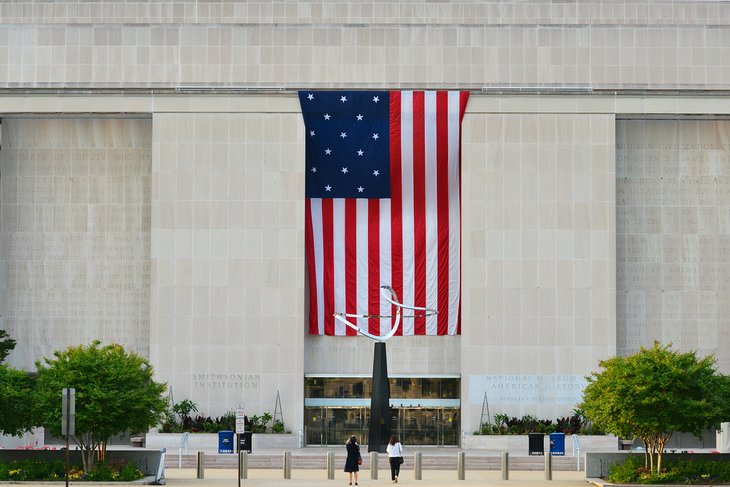
Illustrating these multiple themes are artifacts that include everything from gowns, work by First Ladies, and Julia Child's complete kitchen to the Muppets and the actual ruby slippers Judy Garland wore in the film Wizard of Oz. With all the historical things to do in Washington D.C., you might think your family has had enough history. But this engaging museum houses some fascinating exhibits and artifacts of our collective past that will appeal to all ages.
Address: 14th Street NW at Constitution Avenue NW, Washington, D.C.
Official site: http://americanhistory.si.edu
Jefferson Memorial and Tidal Basin
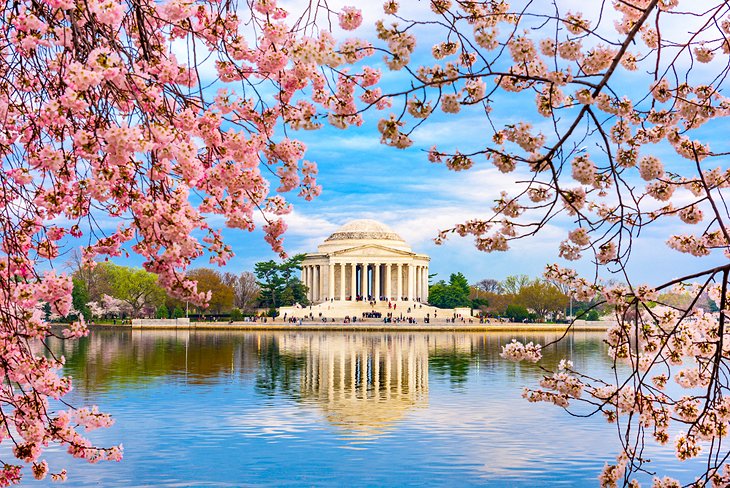
The design for the domed white memorial to Thomas Jefferson, the third US president, is based on the Roman Pantheon, its low dome supported by 54 Ionic columns. Inside, appearing in a dramatic silhouette through the columns is a 19-foot statue of a standing Jefferson, and around are engraved excerpts of the Declaration of Independence and other writings.
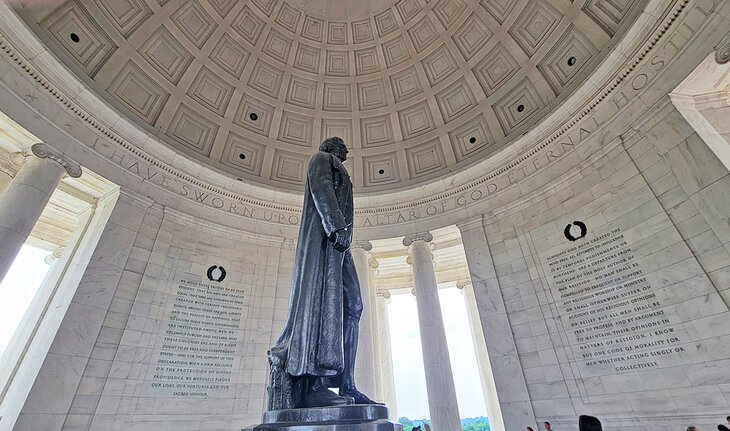
The monument stands alone at the far end of the Tidal Pool, which reflects the monument on its surface, and all around the edge of the water are cherry trees, a gift from Japan. These are one of Washington's greatest attractions when they bloom each spring, surrounding the basin with a cloud of pink flowers and celebrated with the Cherry Blossom Festival.
Along the Cherry Tree Walk around the Tidal Basin, the Franklin Delano Roosevelt Memorial reflects twelve years of American History through four outdoor rooms. Each one is devoted to one of FDR's terms of office as he guided the country through the Great Depression and World War II. Unveiled in 2011, the 30-foot-high Martin Luther King Jr. Memorial is the newest along the Tidal Basin.
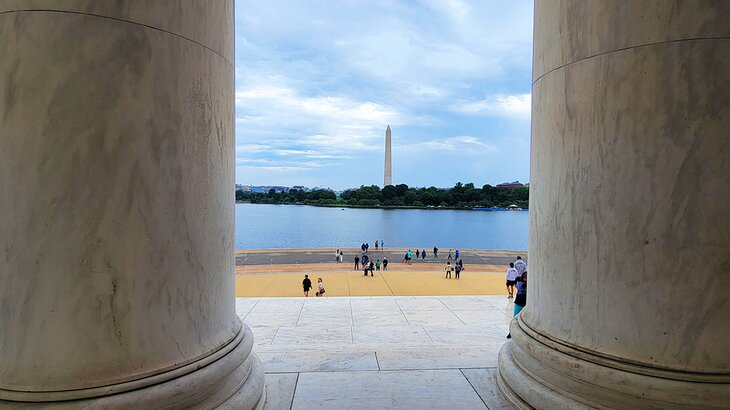
In the summer, you can rent a paddle boat and head out on the Tidal Basin to enjoy the water and get fantastic views of the monument. The blue boats are located at a dock across from the monument, off Maine Ave SW, at Floral Park.
Address: 900 Ohio Drive SW, Washington, D.C.
The John F. Kennedy Center for the Performing Arts

Opened in 1971 and named in memory of President John F. Kennedy, the National Cultural Center overlooks the Potomac River in a state-of-the-art building designed by architect Edward Durell Stone. It is home to the National Symphony Orchestra, which hosts some of the world's greatest guest artists each year, and the Washington National Opera, one of the nation's leading opera companies.
Its three main stages and several smaller stages present over 2,200 performing arts shows and events each year, about 400 of which are free. These represent all types of music and theater, both classical and contemporary.
Joining the Los Angeles Music Center and Lincoln Center in New York as one of the three most important venues in the United States, the Kennedy Center is a major stop for visiting overseas opera, dance, and drama companies on tour.
Address: 2700 F Street NW, Washington, D.C.
Official site: www.kennedy-center.org
National Zoological Park
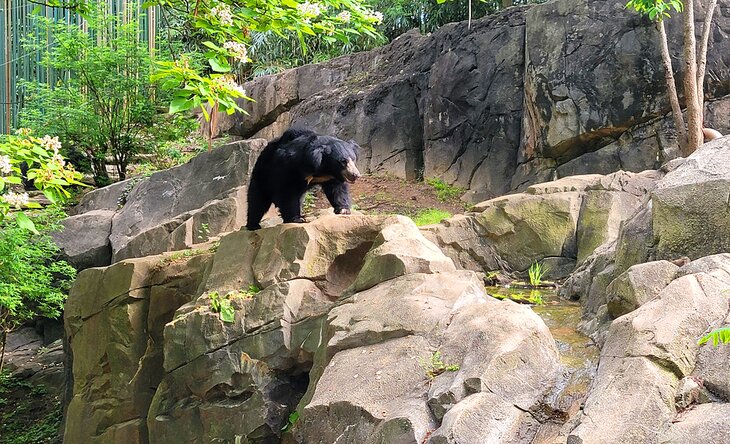
The National Zoo is the most popular of the Smithsonian attractions. It is one of the world's best zoos, not only for the quality of the experience but for its leadership in areas of animal care and sustainability.
Nearly 2,000 different animals, birds, and reptiles live in habitats replicating their natural environments as closely as possible. Of the several hundred species represented here, about a quarter are endangered.
One of the zoo's star attractions, the giant pandas left the zoo in late 2023 but they are coming back in late 2024. Other highlights include red pandas, Sumatran tigers, western lowland gorillas, Asian elephants, cheetahs, white-naped cranes, and North Island brown kiwis. You can also watch otters play, or walk through the aviary to enjoy birds flying overhead.

In the Amazonia exhibit, you can glimpse the colorful underwater life of the Amazon, where one of the world's largest freshwater fish swims beneath a living tropical forest.
Along with the cheetahs at the Cheetah Conservation Station, you can see Grevy's zebras, dama gazelles, vultures, and red river hogs, and at the highly popular Elephant Trails, you can see the multigenerational herd and learn about the elephants' life at the zoo and in the wild.
Check the day's schedule for feeding times, demonstrations, educational games, and talks. As you might expect, this is one of Washington's favorite places to visit for children.
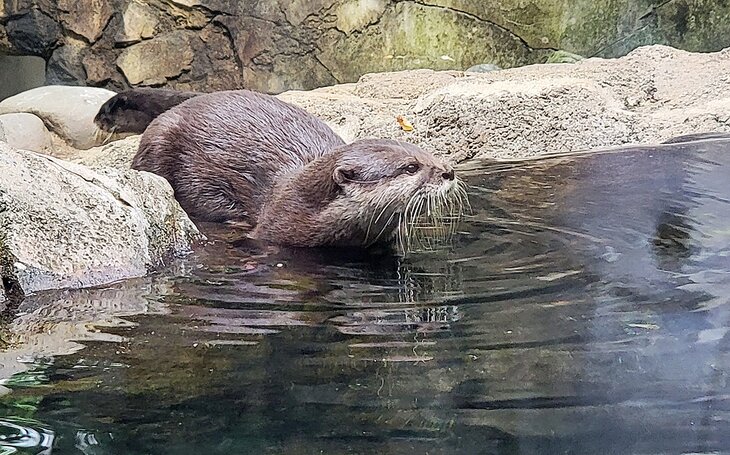
Although the zoo is free, you must book a timed entrance admission. You can book an entry time up to one hour before closing.
The zoo is north of downtown, quite a distance from the main attractions but you can easily take public transit. The closest metro stop is about a four-block walk from the entrance and a bus stop is right outside the zoo. Metro cards (SmarTrip) are good for trains and buses.
Address: 3001 Connecticut Avenue NW, Washington, D.C.
Official site: http://nationalzoo.si.edu
National Archives

The National Archives holds permanent records of the U.S. Congress, the U.S. Supreme Court, District of Columbia courts, and some federal agencies, as well as pre-World War I military service records for U.S. Army and Confederate veterans, and pre-1940 vessel and station logbooks for the U.S. Navy.
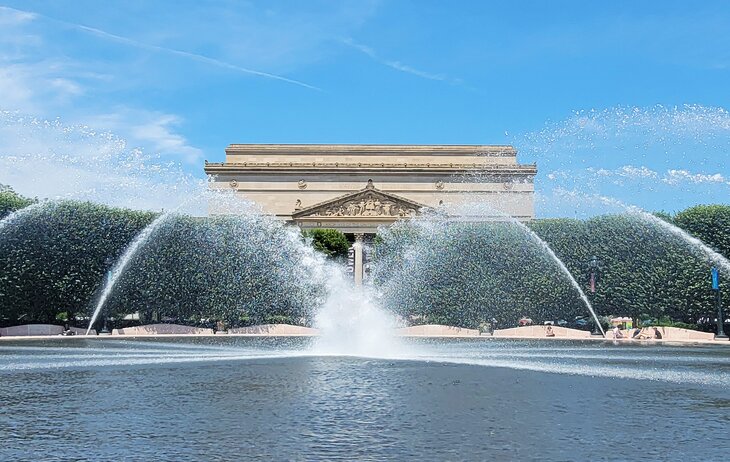
The records are open to researchers, and in the Rotunda, you can see the Declaration of Independence, Constitution, and Bill of Rights. Exhibition galleries feature a 1297 Magna Carta and a changing group of other historically significant documents. An exhibit, Rightfully Hers: American Women and the Vote, includes documents from the suffrage movement, and in other areas are interactive exhibits and hands-on activities for all ages.
In front of the building is a large pond and fountains with benches around the edges for relaxing.
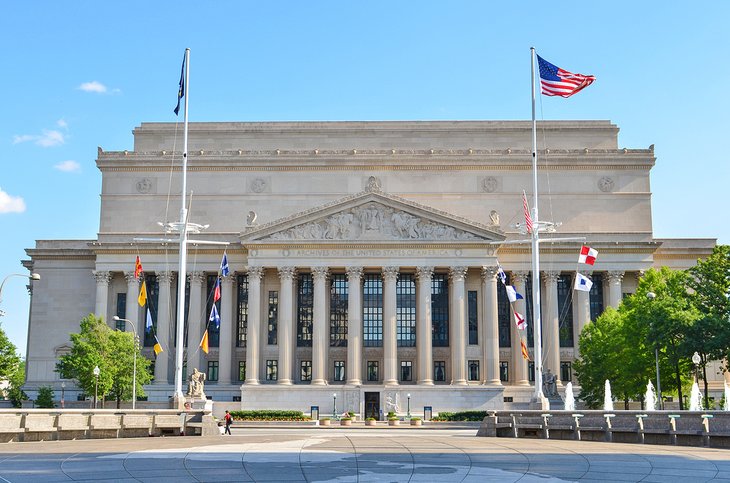
Address: 701 Pennsylvania Avenue NW, Washington, D.C.
Official site: https://museum.archives.gov
International Spy Museum

The place for 007 wannabes, the museum covers the techniques, technology, history, and contemporary role of espionage. Many of the exhibits are interactive, and throughout the building are actual examples of real espionage equipment (including a poison dart umbrella designed by the KGB), from declassified hardware and captured equipment to movie props used in the James Bond series.
Photographs, audio-visual programs, and special effects combine to give a picture of strategies and methods behind secret espionage missions. The collections include historic spy artifacts from the Revolution and Civil War, along with a wealth of ingeniously concealed and disguised cameras and weapons, even the famous Enigma cipher machine that broke the Nazi codes in World War II.
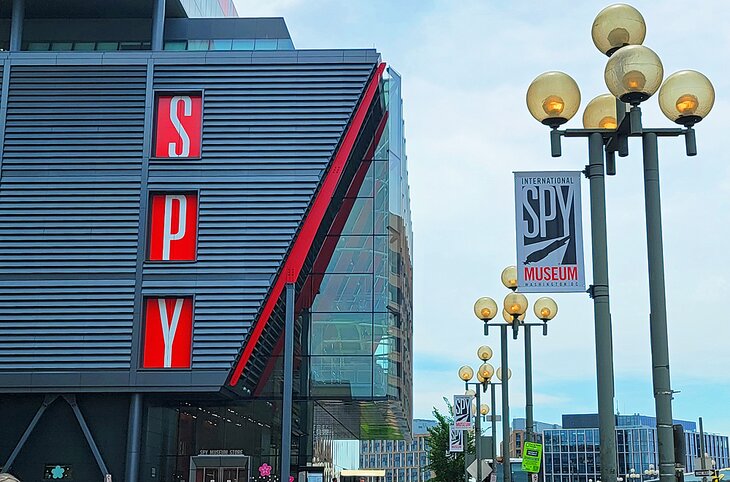
The top floor is dedicated to real-life spies Aldrich Ames, Robert Hanson, and John Walker, detailing the actual methods and tools they used to spy on the United States, with videos describing how spies were caught. The lower floor moves from fact to fiction, filled with information and actual props used in James Bond movies.
Highlighting these is the Aston Martin DB5 that first appeared in the 1964 film Goldfinger, equipped with machine guns, oil jets, a dashboard radar screen, an ejector seat, tire slashers, a bulletproof shield, and a rotating license plate. The car actually inspired intelligence agencies to add similar features to their own vehicles.
Upon arrival, you are given your own spy mission, complete with a fake identity, cover story, and a card. As you progress through the exhibits you can use your identity card at terminals set up throughout the museum to get updates on your mission. This is completely optional but can be fun if you are looking for an interactive experience.
Address: 700 L'Enfant Plaza, SW; Washington, D.C.
Official site: www.spymuseum.org
Arlington National Cemetery
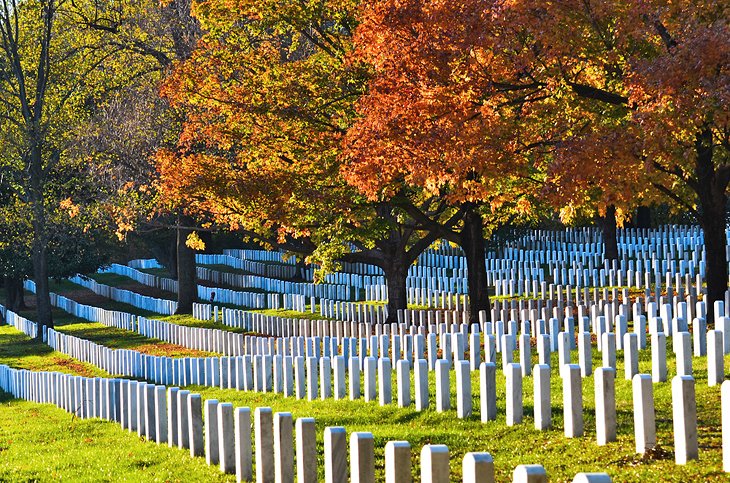
On a hillside overlooking the city from across the Potomac River, Arlington National Cemetery is filled with memorials to American history and the men and women who were part of it. Its best-known landmarks are the Tomb of the Unknown Soldier, President John F. Kennedy's gravesite, and the U.S. Marine Corps War Memorial depicting the raising of the flag on Iwo Jima in World War II. The Welcome Center has maps, information (including the locations of specific graves), and exhibits telling the story of Arlington National Cemetery and its monuments.
Among these are memorials to nurses, Iran Rescue Mission casualties, and various battles and groups, including one at the graves of Lt. Cmdr. Roger B. Chaffee and Lt. Col. Virgil I. "Gus" Grissom, who were killed in a fire aboard their Apollo spacecraft. Another commemorates the seven Challenger astronauts.
In a solemn and impressive ceremony, the guard at the Tomb of the Unknown Soldier is changed every hour on the hour from October 1 to March 31, and every half hour from April 1 through September 30. Although the cemetery is not right in the city, both the Washington Metropolitan Area Transit Authority's Metrorail system and Metrobus have stops close to the gate.
Official site: https://www.arlingtoncemetery.mil
Washington National Cathedral
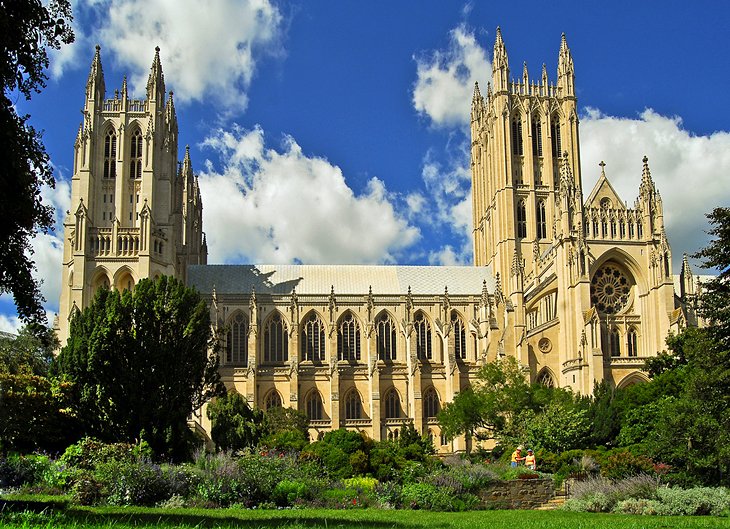
The English-style, Neo-Gothic National Cathedral, one of the world's largest cathedrals, took 83 years to build, from 1907 to 1990. It follows the Gothic building style and techniques, with flying buttresses and solid masonry construction of Indiana limestone. Throughout the cathedral are artistic details to see, from its stained-glass windows to the hand-embroidered kneelers that commemorate war heroes and historic events.
Special tours, reserved in advance, explore hidden parts of the building and its art; families should ask for the brochure Explore the Cathedral with Children for a scavenger hunt to find wrought-iron animals, tiny carvings, and gargoyles. Be sure to look for the gargoyle of Darth Vader high up on the northwest tower.
The cathedral is the burial place of President Woodrow Wilson and Helen Keller, and state funerals for Presidents Eisenhower, Reagan, and Ford took place here. The top of the 300-foot central tower is the highest point in Washington.
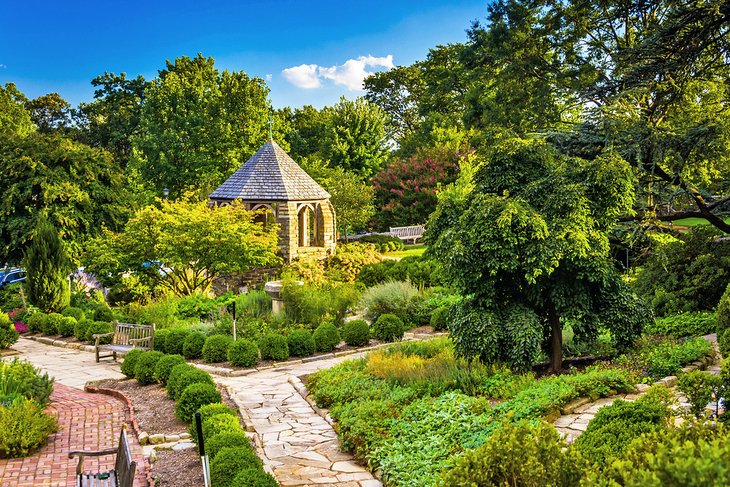
The Bishop's Garden, on the south side of the cathedral, includes plants found in medieval gardens, plants mentioned in the Bible, and others native to the area, along with a fish pond. The 59-acre Cathedral Close, designed by the eminent landscape architect Frederick Law Olmsted, Jr in the early 20th century, is an urban oasis modeled on the walled grounds of medieval cathedrals.
Carillon recitals are held each Saturday at 12:30pm, and the peal bells are rung on Tuesday evenings from 7 to 9pm and after Sunday services. On Mondays and Wednesdays at 12:30pm, a cathedral organist discusses the Great Organ here, followed by a mini-recital.
Address: Massachusetts & Wisconsin Avenues NW, Washington, D.C.
Official site: www.cathedral.org
Georgetown Historic District

The neighborhood from 27th to 37th Streets, between Rock Creek Park and K Street NW, is the city's oldest, with origins in the early 1700s, before Washington itself. Georgetown University, the nation's oldest Roman Catholic and Jesuit College, is located here.
Today, Georgetown's tidy streets of historic homes and its boutique shops, cafés, restaurants, and small museums make it a popular respite from lines at the mall attractions. The C&O Canal, the 184-mile waterway paralleling the Potomac River, begins here, and its towpath is a favorite place for walking and cycling.
Dumbarton Oaks is a 16-acre estate with formal gardens and a valuable Byzantine and Christian art collection. Federal period Dumbarton House features Federal-style furniture, paintings, textiles, silver, and ceramics, and is home to one of five original known copies of the Articles of Confederation.
Tudor Place is an early 19th-century mansion built by Martha Washington's granddaughter, Martha Custis Peter, and her husband. Items from George and Martha Washington's Mount Vernon home are shown here, and the Federal-period gardens contain plants and trees from the early 19th century. The Kreeger Museum displays a wide collection of art from the 1850s to the 1970s including paintings by Monet, Renoir, Sisley, Chagall, Gauguin, and Picasso.
If you're looking for places to eat in Washington or things to do at night, this is one of the places to visit. The neighborhood is filled with restaurants and cafes, along with live music venues.
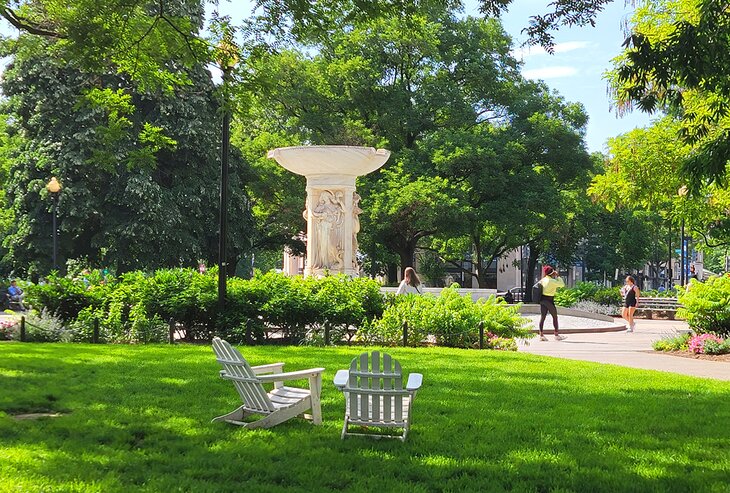
The nearby Dupont Circle neighborhood is another great place to head for dining and nightlife. This area, east of Georgetown in the northwest corner of downtown Washington, is near several embassies and offers lovely outdoor spaces and a fantastic mix of restaurants.
You'll find excellent high-end dining, casual restaurants, and an assortment of different ethnic foods. Try Balos Estiatorio for something upper-end and Mediterranean, or head next door to Colada Shop for a laid-back atmosphere and tasty Cuban food. If you just want to relax, walk to Dupont Circle Fountain and kick back in a chair on the lawn.
Smithsonian American Art Museum and National Portrait Gallery
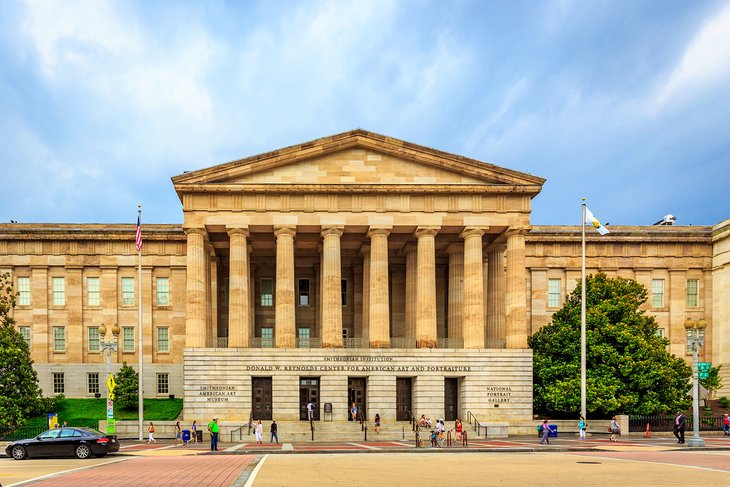
Sharing the historic Old Patent Office Building with the National Portrait Gallery, the Smithsonian American Art Museum holds one of the world's largest and most inclusive collections of American art, representing more than 7,000 artists from the colonial era to the present.
The collections record the wonder of artists capturing the beauty of American landscapes as the nation expanded westward, and the changing face of American cities and towns. Special collections represent works by more than 200 African American artists, collections of Latinex works, an outstanding array of contemporary American craft and folk arts.
The National Portrait Gallery focuses on famous Americans, from the time of the first colonies to present-day leaders and important public figures, including the only complete collection of presidential portraits outside of the White House.
Address: 8th and G Streets NW, Washington, D.C.
Official sites:
U.S. Botanic Garden
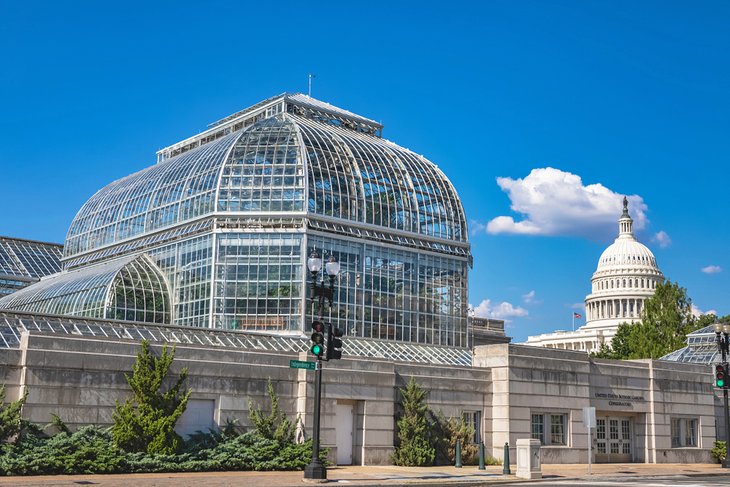
At the foot of Capitol Hill, the U.S. Botanic Garden is an oasis of tropical gardens in the center of the city. Surrounded by outdoor gardens, the huge glasshouse is the hub of a museum of living plants. Permanent interior exhibits create environments for plants at home everywhere from the desert to rainforests, while outside is a showcase of plants that thrive in the Middle Atlantic states.
The greenhouse contains two courtyard gardens and 10 garden rooms, and the outside displays include a pollinator garden, rose garden, kitchen garden, and water garden. There's always something in bloom, and benches in the vast conservatory invite a stop to enjoy the fragrances and the lush green surroundings.
Address: 100 Maryland Avenue, SW, Washington, D.C.
Official site: https://www.usbg.gov/
U Street Corridor
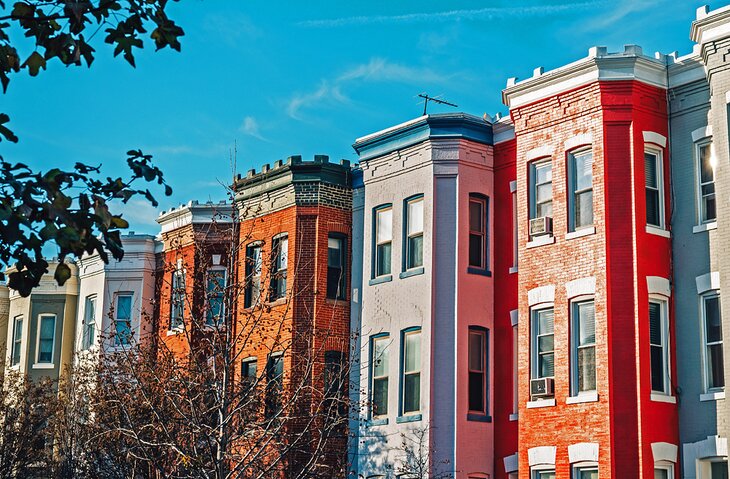
D.C.'s U Street Corridor is one of the city's top historic neighborhoods and served as the epicenter of Black culture in America between 1862 and 1948. Designated a historic district in 1998, this neighborhood is filled with colorful buildings housing plenty of shops, restaurants, and theaters.
It is anchored by 14th Street on its west side and the recently renovated Howard Theatre on its east end at the edge of the Shaw neighborhood. Constructed in 1910, this was the center of Black Broadway for the first half of the 20th Century. It fell into decline but underwent a magnificent renovation and reopened a decade ago.
Duke Ellington was born in this neighborhood and a sculpture honoring the famed jazz musician can be seen at the intersection of Florida Ave and T Street. Also check out a concert at Lincoln Theatre, built in 1922, where Ellington and other jazz greats like Billie Holiday, Nat King, Cole, and Louis Armstrong all used to play.
U Street is known for its delicious food scene. Here you'll find the acclaimed Ben's Chili Bowl, which has served everyone from Anthony Bourdain to Barack Obama. Its restaurants span the globe, however. If you are craving authentic Ethiopian fare, head to "Little Ethiopia" on the east end of U Street.
The Wharf
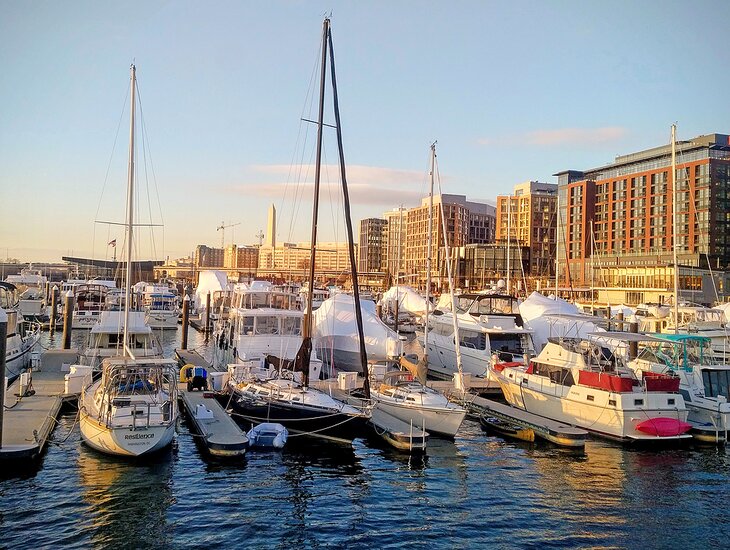
With its second phase only completed in 2002, The Wharf is D.C.'s hottest new waterfront neighborhood, home to more than 80 restaurants and shops, an iconic fish market, four hotels, and a popular live music venue. Running along the Potomac River for one mile, the neighborhood was created as part of a larger development plan for what had been a neglected portion of the SW quadrant.
Just about a 10-minute walk from the National Mall, The Wharf's waterfront location provides a totally different vibe than the memorial and museum area. The Municipal Fish Market is the country's oldest continuously operating open-air fish market, originally opened in 1805. Until the redevelopment of The Wharf, it wasn't really on the tourist map anymore. Today it is buzzing with hungry travelers and locals alike, who come here to dine al fresco on fresh fish.
If you want to get out on the Potomac River yourself, you can rent a kayak or paddleboard to explore. There are also seasonal water taxis running from The Wharf to Old Town Alexandria, Virginia, across the river. Alexandria is known for its stately 18th- and 19th-century buildings and brick streets. It's a great place to wander around for an afternoon. Water taxis also run to Georgetown.
Come evening, book a luxe riverboat dinner cruise on Potomac. These offer a wonderful way to relax after an action-packed day, and river sunsets can be phenomenal.
Official site: https://www.wharfdc.com/
Best Time to Visit Washington, D.C.
Weather wise, the best time of year to travel to Washington, D.C. is between the months of March and May and September to November. You'll hit cherry blossom season (usually from late March to early April), ogle spectacular fall foliage (especially in October through November), and enjoy a long stretch of great weather free from frigid and sweltering temps.
| Average minimum and maximum temperatures for Washington, DC in °C | |||||||||||
| J | F | M | A | M | J | J | A | S | O | N | D |
| 6 -3 | 8 -1 | 13 3 | 19 8 | 24 13 | 29 18 | 31 21 | 30 21 | 26 17 | 20 10 | 14 4 | 8 0 |
| PlanetWare.com | |||||||||||
| Average monthly precipitation totals for Washington, DC in mm. | |||||||||||
| 82 | 67 | 91 | 70 | 97 | 80 | 93 | 87 | 96 | 82 | 77 | 78 |
| Average monthly snowfall totals for Washington, DC in cm. | |||||||||||
| 16 | 16 | 4 | 0 | 0 | 0 | 0 | 0 | 0 | 0 | 3 | 8 |
| Average minimum and maximum temperatures for Washington, DC in °F | |||||||||||
| J | F | M | A | M | J | J | A | S | O | N | D |
| 42 27 | 47 30 | 56 37 | 66 46 | 75 56 | 84 65 | 88 70 | 86 69 | 79 62 | 68 50 | 57 40 | 47 32 |
| PlanetWare.com | |||||||||||
| Average monthly precipitation totals for Washington, DC in inches. | |||||||||||
| 3.2 | 2.6 | 3.6 | 2.8 | 3.8 | 3.1 | 3.7 | 3.4 | 3.8 | 3.2 | 3.0 | 3.1 |
| Average monthly snowfall totals for Washington, DC in inches. | |||||||||||
| 6.2 | 6.3 | 1.6 | 0 | 0 | 0 | 0 | 0 | 0 | 0 | 1.0 | 3.1 |
More Related Articles on PlanetWare.com
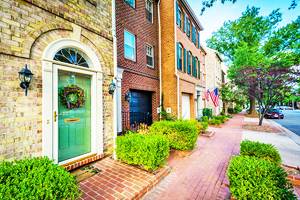
Places to Visit Close to Washington: If you have time to explore outside the city, there are many easy Day Trips from Washington, D.C.

Exploring Maryland: There are a number of tourist attractions in Maryland, including those in historic Annapolis and Baltimore with its lively harbor area. The state is also famous for its beaches and oceanfront resorts, many of which are within easy weekend reach from Washington. You can learn more about these on our page Resorts in Maryland.

Discovering Virginia: The District of Columbia lies between two states, and to its south, you can visit attractions in Virginia, including those in the capital city of Richmond. Or you could spend a weekend immersed in colonial history with the help of our page Tourist Attractions in Williamsburg & Easy Day Trips.


